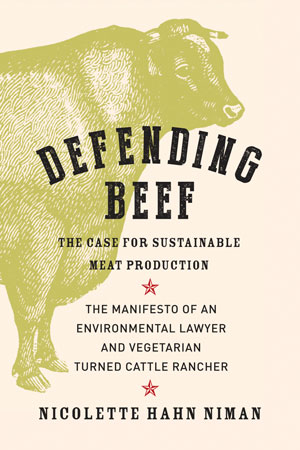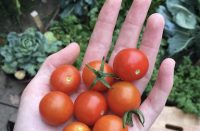There is a longstanding consensus among the ecologically aware and the health conscious that beef is bad. At the site of production, cattle operations are widely understood to be resource-intensive and to have various negative outputs, including biological waste and plenty of carbon. At the site of consumption, we have long been told that the cholesterol and saturated fat in the beef on our plates will cause every chronic and degenerative illness from obesity to heart disease.
In Defending Beef: The Case for Sustainable Meat Production, Nicolette Hahn Niman aims to challenge some of those assumptions. To be sure, Hahn Niman does not intend to defend business as usual, the industrial food system in which corn-stuffed animals from concentrated feeding operations end up as tasteless pieces of meat in the grocery store display. Her vision is a much more optimistic one of farms raising grass-fed livestock in ways that might even reduce atmospheric carbon and deliver a final product that is both delicious and nutritious.
The first and most convincing part of Defending Beef elaborates the book’s subtitle: the case for sustainable meat production. Beginning with the issue of greenhouse gases, Hahn Niman offers ample scientific data to show that how cattle are raised significantly determines the quantity of emissions. Corn- and grain-heavy feeding results in high emissions levels. However, the real source of all the carbon dioxide, the author argues, is the fossil fuel needed to grow the corn and grain and then transport it long distances to concentrated feeding lots. Allowing cows to roam freely in the pasture, consuming the diet of grass and forage to which they are biologically adapted, keeps carbon and nutrients in local ecosystems.
Referencing credible soil science, Hahn Niman argues that converting cropland to pasture can actually sequester carbon. In the most engaging and inspiring chapters of the book, Hahn Niman describes the complex relationships between grazing cattle and their ecosystem. With plenty of evidence, she shows that a grass-fed approach to cattle farming can actually increase ecosystem biodiversity as well as improve the health of the soil. Hahn Niman does justice to the argument that raising cattle is not necessarily ecologically destructive and, in fact, the opposite can be true.
Beef – especially grass-fed – can and should be a part of a balanced diet.
In the second part of the book the analysis turns to the health issues concerning beef consumption. In recent years, the long-held dogma that eating animal fat causes obesity and degenerative disease has slowly been worn down. While some studies show correlation between beef and negative health outcomes, many others refute this. Most telling, Hahn Niman argues, is that while consumption of saturated fat and red meat has steadily decreased over several decades, rates of heart disease and obesity have increased. In fact, she shows, beef – especially grass-fed – can and should be a part of a balanced diet. It is a healthy source of calories and provides important micronutrients, many in uniquely bioavailable forms.
Hahn Niman does an excellent job of defending beef. Unfortunately, some issues arise when she goes on the offensive. If red meat and fat are not to blame for declining health, the culprit must be carbohydrates. While she is likely correct that sugar is part of the problem, her attack on sucrose is far longer than it needs be. The analysis deteriorates further when she points the finger at all grains and takes the drastic step of praising “paleo” and Atkins-type fad diets. In reality, the epidemiological research on carbohydrates is in its infancy and its implications are far from clear. Most importantly, the indictment of carbohydrates is simply not necessary for the book’s argument.
Ultimately, the greatest strength of Defending Beef is its realistic attitude. Hahn Niman does not advocate for an immediate and total conversion to organic, grass-fed beef production. Nor does she tout the health benefits of grass-fed beef (which only the affluent can reasonably afford) at the expense of all else. The message that readers take home is that for a long time before its industrialization, beef worked. In the context of ecological degradation, epidemics of chronic and degenerative diseases and worldwide food insecurity, traditional methods aided by modern science can and should make beef part of the solution, instead of a contributor to the problem.
Defending Beef: The Case for Sustainable Meat Production, Nicolette Hahn Niman, White River Junction, VT: Chelsea Green Publishing, 2014, 288 pages.
Reviewer Information
Tom Cheney is a PhD candidate in the Department of Political Science at York University, Toronto. His research explores humanity’s place in nature.













